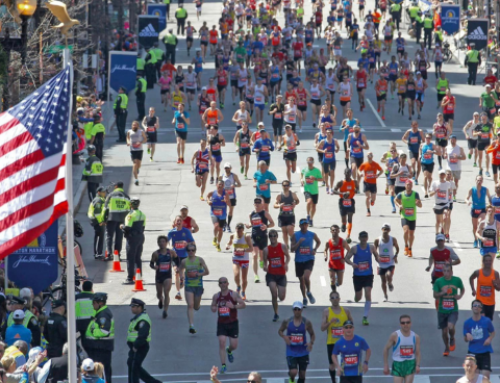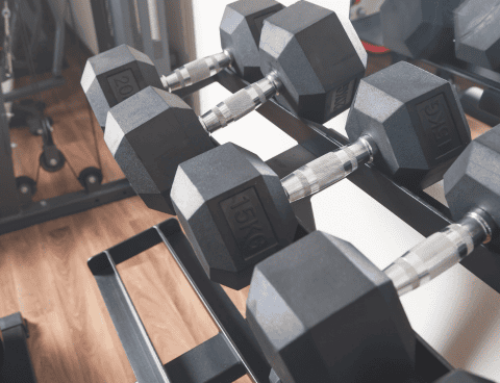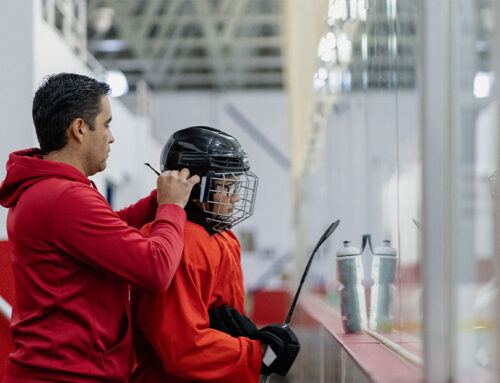I Tried LeBron’s Favorite Workout Tool, and it Totally Kicked My Butt
It’s only been 10 minutes, but there’s already a pitcher’s worth of sweat on the floor beneath me.
My legs are on fire. My heart is racing faster than the EDM music that’s thumping around me. I continue to pump my arms and legs in an alternating, rhythmic fashion. One, two. One, two. One, two.
Dan, my instructor, yells out that we’re going to go into a sprint—a 15-second burst of all out effort. He counts me in, and my hands and feet go into hyperdrive. My adrenaline reserve drops as my body’s cries for mercy grow louder.
The machine inflicting this punishment on me is the VersaClimber, a 7-foot tall device with little more than a set of handles, a set of pedals, a resistance knob and an LED display. It’s a deceptively simple apparatus capable of dealing a devilishly effective cardio workout. It also happens to be the tool behind LeBron James’ seemingly infinite reserve of on-court energy.
“If I could only have one piece of equipment to train with for the rest of my life,” James told ESPN in May. “(The VersaClimber) would be it.”
[instagram src=”https://www.instagram.com/p/BHm1pkeh299/”]I first learned of the VersaClimber a little over a year ago. I was enamored with the concept—a low-impact machine that makes for a killer cardio workout while also reinforcing proper movement patterns—so I set out to write a piece on it. I found out that a number of Cleveland Cavaliers players (including James) regularly went to Rise Nation, a VersaClimber gym in West Hollywood, when they were in the Los Angeles area. I reached out to Rise Nation owner Jason Walsh and he gave me the full rundown on the machine.
RELATED: Why The VersaClimber is The Next Big Thing in Athlete Training
When I recently found out that Rise Nation was opening its second location in downtown Cleveland—just seconds away from STACK’s content office—I knew I had to give it a shot. In the time since I’d written my first VersaClimber article, the machine had grown in popularity. The Cavs had seven of them at their practice facility last season (one machine retails for roughly $4,000), and athletes such as Ben Simmons and Cris Cyborg have recently been spotted VersaClimbing.
I wasn’t quite sure what I was getting myself into as I prepared for my first date with the VersaClimber, but I knew it was going to hurt. I’d seen Kyrie Irving describe it as a machine “made for the strong” and James Jones talk about how it tests your “mental resolve.” I’d also read tweets like these from elite athletes who are in much better shape than myself:
VERSACLIMBER is the worst exercise known to man! #TotalBodyWorkout #NeedIt #RoadToRecoveringTheseLungs
— David Johnson (@DavidJohnson31) February 20, 2017
Had my first date with the @VersaClimber today…should be able to operate again normally by Easter. That thing is no joke.
— Johnny Hekker (@JHekker) April 13, 2017
#FF @VersaClimber one of the things I love to hate! No cheating on this! #cardio #endurance #strength #ufc pic.twitter.com/HnfbxYm2gT
— Tyron T-Wood Woodley (@TWooodley) May 23, 2014
My only comfort was that I’d signed up for a “Level One” introduction class at Rise Nation, so I knew I wasn’t going to be subjecting myself to quite the same level of abuse LeBron endures.
I walked into Rise Nation ahead of my 6 p.m. class with a mix of dread and nervous excitement. The studio features no training equipment other than VersaClimbers. Classes are led by instructors who bump their own music and control a dynamic lighting system as they guide participants through 30-minute workouts. It brings a whole new meaning to the term “fitness club.” Thirty minutes might not sound like a whole lot, but I’d soon find out it was more than enough time to get my butt kicked by the VersaClimber (the machine’s ability to crush calories in a short amount of time is one of its most attractive features. A Men’s Health study found that VersaClimbing burned 22.3 calories per minute compared to 13-14 calories per minute for cycling, treadmill and rowing).
After I checked in and signed a waiver (the first class is free), I gravitated toward a machine near the center of the studio. Derek Millender—the Cavs’ strength and conditioning coach and a partner with Walsh in making Rise Nation Cleveland a reality—came over and helped me get settled in.
Detachable handles allow you to adjust the machine to your height (the handles should be roughly at your shoulders when you’re in the neutral position). An LED display shows you how many total feet you’ve climbed, your stroke length (essentially how many inches you’re moving the handles on each stroke), a timer and a couple other figures. A resistance knob sits directly below the display.
Millender informed me that much of the class would consist of “medium-length” strokes—which should measure roughly 6 to 12 inches in length. “Bottoming out”—a symptom of pushing the foot pedals so far that they hit their endpoint—should be avoided and I should focus on keeping my core engaged as I climb. I was informed that if my hands or feet get tingly or numb (a fairly common occurrence for first-time climbers), I should take a moment to shake them out.
Soon enough, hip-hop was blaring through the speakers, and Dan was leading the class through a warm-up song. At Rise Nation, each song can be seen as a different interval of the workout. During some songs, you’ll focus on just one stroke type. Others will have you integrating different stroke lengths in pre-determined patterns. Sprints are accompanied by more up-tempo songs, and slower, more resistance-focused intervals are generally accompanied by slower songs.
It didn’t take long for me to realize why professional athletes love to hate the VersaClimber. After just a few minutes, my heart rate had climbed and sweat was quickly collecting on my brow. The machine requires what’s known as “alternating reciprocal movement,” meaning when you move one arm up or down, the opposite knee follows suit. Alternating reciprocal movement is the foundation of everything from crawling to sprinting.
“You’re in a natural position. You’re utilizing the upper and lower body together in unison, the way you’re supposed to,” Walsh says. “It’s reinforcing proper movement patterns. During training and everyday life, we can get so far from moving the right way. That really screws the body up and leads to weaknesses and injuries.”
Indeed, performing alternating reciprocal movement in this plane was a new experience for me—and my body could feel it. As the class picked up pace, my legs gradually became more noodle-like. When one song required me to get into a “Squat” as I climbed—essentially moving my butt down further while continuing to keep my chest up and core engaged—my legs were flat-out on fire. This wasn’t like a treadmill or a stationary bike where I could find solace by leaning forward on a set of handles—the VersaClimber has you fighting gravity the entire way. While I felt the movement mostly in my lower half, I did notice a considerable burn in my back and biceps, too.
By the time I reached the halfway point of the class, I was drenched. Fifteen minutes on a treadmill or a stationary bike never had me so soaked in sweat, no matter how fast I was moving. But I continued to climb, bolstered by the beat of the music and the assurance that an NBA 10-day contract awaited me on the other side (a guy can dream, right?). However, I did need to take a 10-second break after one song just because I was so winded (we were encouraged to take breaks whenever we needed to re-hydrate or just to catch our breath).
As I drew closer to the finish line, my legs were in a constant state of agony. But that agony shouldn’t be mistaken for the joint-rattling impact some experience while running on a treadmill—the VersaClimber is extremely low-impact, and my pain was confided to my muscles. That factor is a big reason why LeBron counts the VersaClimber as his favorite workout tool. “No pounding on the joints. No wear on his back, his knees, his ankles, all that, his hips. It’s just all non-weight-bearing cardio. It was a godsend, really,” Mike Mancias, James’ long-time personal trainer, told ESPN.
The clock was drawing close to the 30-minute mark, and I was determined to totally drain myself. The last song of the session was another “sprint” song, and I knew there was a light at the end of the tunnel. I closed my eyes and pushed through the now crushing amount of fatigue that permeated ever fiber of my being. Just as my last ounce of energy was being spent, the timer crept over the 30-minute mark.
I stepped off the machine with a sigh of relief and followed along with the instructor in a quick cooldown. I couldn’t help but feel slightly embarrassed at the small lake’s worth of sweat underneath my machine. I noticed my total feet climbed for the session was about 3,200, which I was informed was quite good for a beginner. But considering that I’m 6-foot-6, and it’s easier for tall athletes to accumulate greater distances on the VersaClimber, I couldn’t let myself get too cocky.
I did my best to walk out of the studio on shaky legs. I was instantly sore, and spent much of the night laid up on the couch and eating anything I could get my hands on. I actually felt a little less sore the next morning, and my legs gradually came back from the dead as I moved about my day. I’ve since taken part in a couple more classes, and my comfort and endurance on the machine have continued to grow. I’m even thinking about taking on a Level Two class (I’m coming for you, LeBron).
If you’re really looking to see how the best athletes in the world get and stay in shape, all you’ve got to do is find the nearest VersaClimber. Just don’t forget to bring a towel.
READ MORE:
RECOMMENDED FOR YOU
MOST POPULAR
I Tried LeBron’s Favorite Workout Tool, and it Totally Kicked My Butt
It’s only been 10 minutes, but there’s already a pitcher’s worth of sweat on the floor beneath me.
My legs are on fire. My heart is racing faster than the EDM music that’s thumping around me. I continue to pump my arms and legs in an alternating, rhythmic fashion. One, two. One, two. One, two.
Dan, my instructor, yells out that we’re going to go into a sprint—a 15-second burst of all out effort. He counts me in, and my hands and feet go into hyperdrive. My adrenaline reserve drops as my body’s cries for mercy grow louder.
The machine inflicting this punishment on me is the VersaClimber, a 7-foot tall device with little more than a set of handles, a set of pedals, a resistance knob and an LED display. It’s a deceptively simple apparatus capable of dealing a devilishly effective cardio workout. It also happens to be the tool behind LeBron James’ seemingly infinite reserve of on-court energy.
“If I could only have one piece of equipment to train with for the rest of my life,” James told ESPN in May. “(The VersaClimber) would be it.”
[instagram src=”https://www.instagram.com/p/BHm1pkeh299/”]I first learned of the VersaClimber a little over a year ago. I was enamored with the concept—a low-impact machine that makes for a killer cardio workout while also reinforcing proper movement patterns—so I set out to write a piece on it. I found out that a number of Cleveland Cavaliers players (including James) regularly went to Rise Nation, a VersaClimber gym in West Hollywood, when they were in the Los Angeles area. I reached out to Rise Nation owner Jason Walsh and he gave me the full rundown on the machine.
RELATED: Why The VersaClimber is The Next Big Thing in Athlete Training
When I recently found out that Rise Nation was opening its second location in downtown Cleveland—just seconds away from STACK’s content office—I knew I had to give it a shot. In the time since I’d written my first VersaClimber article, the machine had grown in popularity. The Cavs had seven of them at their practice facility last season (one machine retails for roughly $4,000), and athletes such as Ben Simmons and Cris Cyborg have recently been spotted VersaClimbing.
I wasn’t quite sure what I was getting myself into as I prepared for my first date with the VersaClimber, but I knew it was going to hurt. I’d seen Kyrie Irving describe it as a machine “made for the strong” and James Jones talk about how it tests your “mental resolve.” I’d also read tweets like these from elite athletes who are in much better shape than myself:
VERSACLIMBER is the worst exercise known to man! #TotalBodyWorkout #NeedIt #RoadToRecoveringTheseLungs
— David Johnson (@DavidJohnson31) February 20, 2017
Had my first date with the @VersaClimber today…should be able to operate again normally by Easter. That thing is no joke.
— Johnny Hekker (@JHekker) April 13, 2017
#FF @VersaClimber one of the things I love to hate! No cheating on this! #cardio #endurance #strength #ufc pic.twitter.com/HnfbxYm2gT
— Tyron T-Wood Woodley (@TWooodley) May 23, 2014
My only comfort was that I’d signed up for a “Level One” introduction class at Rise Nation, so I knew I wasn’t going to be subjecting myself to quite the same level of abuse LeBron endures.
I walked into Rise Nation ahead of my 6 p.m. class with a mix of dread and nervous excitement. The studio features no training equipment other than VersaClimbers. Classes are led by instructors who bump their own music and control a dynamic lighting system as they guide participants through 30-minute workouts. It brings a whole new meaning to the term “fitness club.” Thirty minutes might not sound like a whole lot, but I’d soon find out it was more than enough time to get my butt kicked by the VersaClimber (the machine’s ability to crush calories in a short amount of time is one of its most attractive features. A Men’s Health study found that VersaClimbing burned 22.3 calories per minute compared to 13-14 calories per minute for cycling, treadmill and rowing).
After I checked in and signed a waiver (the first class is free), I gravitated toward a machine near the center of the studio. Derek Millender—the Cavs’ strength and conditioning coach and a partner with Walsh in making Rise Nation Cleveland a reality—came over and helped me get settled in.
Detachable handles allow you to adjust the machine to your height (the handles should be roughly at your shoulders when you’re in the neutral position). An LED display shows you how many total feet you’ve climbed, your stroke length (essentially how many inches you’re moving the handles on each stroke), a timer and a couple other figures. A resistance knob sits directly below the display.
Millender informed me that much of the class would consist of “medium-length” strokes—which should measure roughly 6 to 12 inches in length. “Bottoming out”—a symptom of pushing the foot pedals so far that they hit their endpoint—should be avoided and I should focus on keeping my core engaged as I climb. I was informed that if my hands or feet get tingly or numb (a fairly common occurrence for first-time climbers), I should take a moment to shake them out.
Soon enough, hip-hop was blaring through the speakers, and Dan was leading the class through a warm-up song. At Rise Nation, each song can be seen as a different interval of the workout. During some songs, you’ll focus on just one stroke type. Others will have you integrating different stroke lengths in pre-determined patterns. Sprints are accompanied by more up-tempo songs, and slower, more resistance-focused intervals are generally accompanied by slower songs.
It didn’t take long for me to realize why professional athletes love to hate the VersaClimber. After just a few minutes, my heart rate had climbed and sweat was quickly collecting on my brow. The machine requires what’s known as “alternating reciprocal movement,” meaning when you move one arm up or down, the opposite knee follows suit. Alternating reciprocal movement is the foundation of everything from crawling to sprinting.
“You’re in a natural position. You’re utilizing the upper and lower body together in unison, the way you’re supposed to,” Walsh says. “It’s reinforcing proper movement patterns. During training and everyday life, we can get so far from moving the right way. That really screws the body up and leads to weaknesses and injuries.”
Indeed, performing alternating reciprocal movement in this plane was a new experience for me—and my body could feel it. As the class picked up pace, my legs gradually became more noodle-like. When one song required me to get into a “Squat” as I climbed—essentially moving my butt down further while continuing to keep my chest up and core engaged—my legs were flat-out on fire. This wasn’t like a treadmill or a stationary bike where I could find solace by leaning forward on a set of handles—the VersaClimber has you fighting gravity the entire way. While I felt the movement mostly in my lower half, I did notice a considerable burn in my back and biceps, too.
By the time I reached the halfway point of the class, I was drenched. Fifteen minutes on a treadmill or a stationary bike never had me so soaked in sweat, no matter how fast I was moving. But I continued to climb, bolstered by the beat of the music and the assurance that an NBA 10-day contract awaited me on the other side (a guy can dream, right?). However, I did need to take a 10-second break after one song just because I was so winded (we were encouraged to take breaks whenever we needed to re-hydrate or just to catch our breath).
As I drew closer to the finish line, my legs were in a constant state of agony. But that agony shouldn’t be mistaken for the joint-rattling impact some experience while running on a treadmill—the VersaClimber is extremely low-impact, and my pain was confided to my muscles. That factor is a big reason why LeBron counts the VersaClimber as his favorite workout tool. “No pounding on the joints. No wear on his back, his knees, his ankles, all that, his hips. It’s just all non-weight-bearing cardio. It was a godsend, really,” Mike Mancias, James’ long-time personal trainer, told ESPN.
The clock was drawing close to the 30-minute mark, and I was determined to totally drain myself. The last song of the session was another “sprint” song, and I knew there was a light at the end of the tunnel. I closed my eyes and pushed through the now crushing amount of fatigue that permeated ever fiber of my being. Just as my last ounce of energy was being spent, the timer crept over the 30-minute mark.
I stepped off the machine with a sigh of relief and followed along with the instructor in a quick cooldown. I couldn’t help but feel slightly embarrassed at the small lake’s worth of sweat underneath my machine. I noticed my total feet climbed for the session was about 3,200, which I was informed was quite good for a beginner. But considering that I’m 6-foot-6, and it’s easier for tall athletes to accumulate greater distances on the VersaClimber, I couldn’t let myself get too cocky.
I did my best to walk out of the studio on shaky legs. I was instantly sore, and spent much of the night laid up on the couch and eating anything I could get my hands on. I actually felt a little less sore the next morning, and my legs gradually came back from the dead as I moved about my day. I’ve since taken part in a couple more classes, and my comfort and endurance on the machine have continued to grow. I’m even thinking about taking on a Level Two class (I’m coming for you, LeBron).
If you’re really looking to see how the best athletes in the world get and stay in shape, all you’ve got to do is find the nearest VersaClimber. Just don’t forget to bring a towel.
READ MORE:












